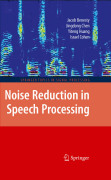
Noise is everywhere and in most applications that are related to audio and speech, such as human-machine interfaces, hands-free communications, voice over IP (VoIP), hearing aids, teleconferencing/telepresence/telecollaboration systems, and so many others, the signal of interest (usually speech) that is pickedup by a microphone is generally contaminated by noise. As a result, the microphone signal has to be cleaned up with digital signal processing tools before it is stored, analyzed, transmitted, or played out. This cleaning process is often called noise reduction and this topic has attracted a considerable amountof research and engineering attention for several decades. One of the objectives of this book is to present in a common framework an overview of the state of the art of noise reduction algorithms in the single-channel (one microphone) case. The focus is on the most useful approaches, i.e., filtering techniques(in different domains) and spectral enhancement methods. Overview of the state of the art of noise reduction algorithms Concise Treatment INDICE: Introduction.- Problem Formulation.- Performance Measures.- Mean-Squared Error Criterion.- Pearson Correlation Coefficient.- Fundamental Properties.- Optimal Filters in the Time Domain.- Optimal Filters in the Frequency Domain.- Optimal Filters in the KLE Domain.- Optimal Filters in the Transform Domain.- Spectral Enhancement Methods.- A Practical Example: Multichannel Noise Reduction for Voice Communication in Spacesuits.
- ISBN: 978-3-642-00295-3
- Editorial: Springer
- Encuadernacion: Cartoné
- Páginas: 240
- Fecha Publicación: 01/04/2009
- Nº Volúmenes: 1
- Idioma: Inglés
